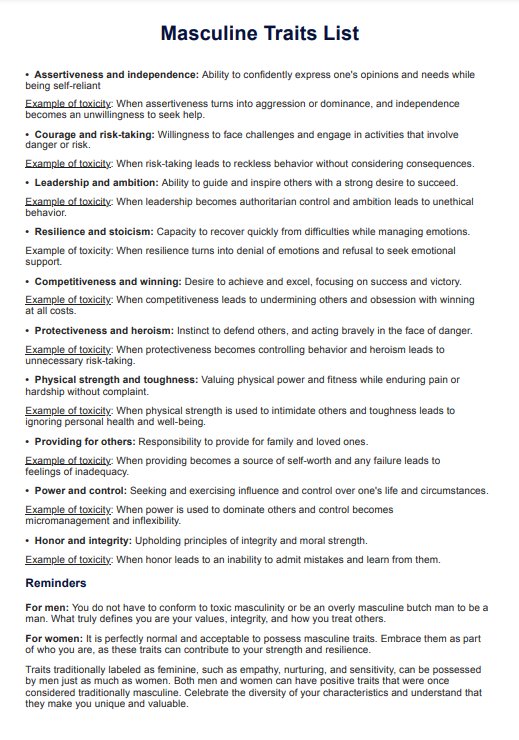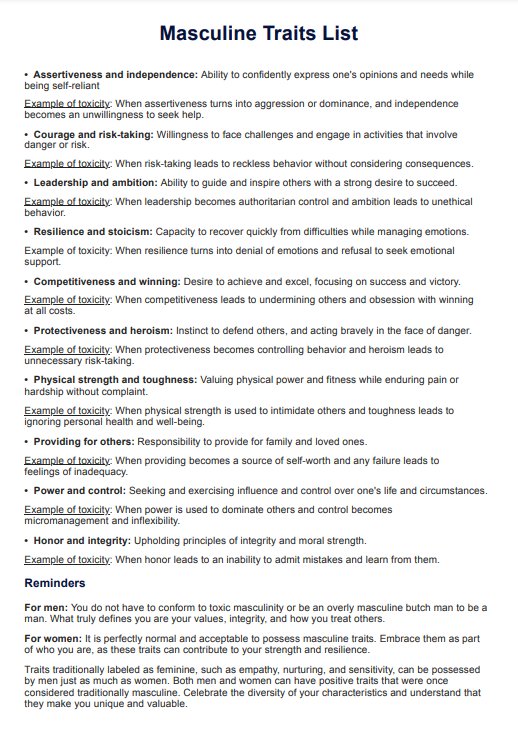Masculine Traits List
Learn about masculine traits, when it starts becoming toxic, and how to use our template for encouraging balanced masculine behaviors.


Masculinity and masculine behaviors
Masculinity refers to the set of attributes, behaviors, and roles traditionally associated with boys and men. These attributes are shaped by cultural, social, and psychological factors. The study of masculinity as a psychological concept gained prominence in the late 20th century, with researchers exploring how societal expectations influence male behavior and identity.
R.W. Connell's theory of masculinity identifies several types of masculinity. Hegemonic masculinity represents the dominant social position of men and the subordinate position of women. Complicit masculinity refers to men who do not fit into the hegemonic model but still benefit from its dominance. Subordinate masculinity includes behaviors that do not conform to the hegemonic ideals and are often associated with femininity or homosexuality. Marginalized masculinity encompasses men who may be racially or economically marginalized but still express traditional masculine traits (Connell, 1995).
Understanding masculinity is important because it shapes individual identities and societal roles. Positive expressions of masculinity can lead to healthy relationships, self-esteem, and personal growth. However, there is a growing recognition of toxic masculinity, which refers to the enforcement of harmful and stereotypical traits common to traditional masculinity, such as suppressing emotions, exhibiting aggression, and dominating others. Toxic masculinity can lead to negative outcomes like mental health issues, relationship problems, and societal violence.
Masculine Traits List Template
Masculine Traits List Example
Masculine vs. feminine traits
Masculine and feminine traits have been culturally and historically categorized into different sets of behaviors, attitudes, and characteristics. Masculine traits are often associated with assertiveness, independence, and physical strength, while feminine traits are linked to nurturing, empathy, and cooperation.
Traditionally, society has associated certain traits with masculinity and others with femininity, but these associations are increasingly being recognized as limiting and not reflective of individual potential. However, it is crucial to understand that these traits are not exclusive to any gender. Both men and women can exhibit a combination of traditionally masculine and feminine traits.
The distinction between masculine and feminine traits lies in societal expectations and stereotypes rather than inherent differences. Recognizing and encouraging a balance of these traits in all individuals can lead to healthier, more holistic personal development and interpersonal relationships. Embracing both sets of traits allows for a more versatile and adaptable personality, breaking away from restrictive gender norms.
Traditional masculine traits
Here are some characteristics that are commonly considered manly. We have included toxic manifestations of these traits:
- Assertiveness and independence: The ability to speak up and stand one's ground, paired with self-reliance. It becomes tocix when assertiveness turns into aggression or dominance, and independence becomes an unwillingness to seek help.
- Courage and risk-taking: The willingness to face danger or try new things. These traits become negative when risk-taking leads to reckless behavior without considering consequences.
- Leadership and ambition: Guiding others and striving for personal success. These qualities become problematic when leadership becomes authoritarian, and ambition leads to unethical behavior.
- Resilience and emotional toughness: Recovering from setbacks and handling emotions privately. When resilience turns into denial of emotions and refusal to seek emotional support, these are harmful.
- Competitiveness and winning: Seeking to achieve and outperform others. These traits become toxic when competitiveness leads to undermining others and obsession with winning at all costs.
- Protectiveness and heroism: Defending others and acting bravely. However, heroism is harmful when it is excessive in such a way that it leads to unnecessary risk-taking and lack of consideration of self.
- Physical strength and stoicism: Valuing bodily power and enduring pain without complaint. These become toxic when physical strength is for violent behavior, intimiadtion, or sexual assault, or when toughness leads to ignoring personal health and well-being.
- Providing for others: Taking responsibility for the welfare of loved ones. This is toxic when even allowing others to help provide leads to feelings of inadequacy.
- Power and control: Seeking influence over one's life and circumstances. These become dangerous when power is used to dominate others or on intimate partner violence, and control becomes micromanagement and inflexibility.
- Honor and integrity: Maintaining strong moral principles. Honor becomes pride when it leads to an inability to admit mistakes and learn from them, which is harmful.
To this day, there still is societal pressure for men to embody these values. Unfortunately, only about 8% of the interventions in modern society against harmful masculinity are actually gender transformative (World Health Organization, 2019). This is problematic, especially since homophobia and anti-femininity are at the core of traditional masculinity (Mankowski & Smith, 2016).
Traditional feminine traits
Below is a list of personality traits that are considered feminine qualities.
- Empathy and nurturing: Caring for others and understanding their emotions.
- Collaboration and teamwork: Working well with others and valuing group harmony.
- Patience and sensitivity: Enduring challenges calmly and being attuned to others' needs.
- Communication and expressiveness: Articulating thoughts and feelings clearly.
- Flexibility and adaptability: Adjusting to changing circumstances.
- Supportiveness and compassion: Offering help and kindness to others.
- Intuition and emotional intelligence: Understanding emotions and using them to guide decisions.
- Grace and modesty: Behaving elegantly and with humility.
These traits are not exclusive to women; in fact, men will also benefit greatly from having these values, both in their personal and professional lives.
Integrating masculine and feminine traits
Encouraging the integration of both masculine and feminine traits leads to well-rounded individuals. Traits such as empathy, patience, and collaboration are valuable for everyone, regardless of gender. Likewise, assertiveness, resilience, and leadership are beneficial for all individuals.
Recognizing that positive traits are not confined to one gender helps dismantle stereotypes and promotes a more inclusive understanding of human potential. It is important to remember that traits often considered negative or toxic, such as aggression or dominance, can also be rechanneled into positive behaviors like assertiveness and leadership when guided correctly.
How to use our template?
To effectively use our Masculine Traits List template, follow these steps:
Step 1: Access the template
First, access the Masculine Traits List template by clicking "Use Template." This button opens the template in the Carepatron app, which also allows you to customize the template to include your branding or other details.
Step 2: Familiarize the patient with the template
Ensure the patient understands the purpose of the template and how it can help them reflect on their traits and behaviors. Explain that it includes a list of traditionally masculine traits and space for self-reflection.
Step 3: Do the worksheet section
Instruct the patient to go through the list of traits and reflect on their presence and impact in their own life. Encourage them to think about how these traits affect their behavior, relationships, and self-perception. Remind them to be honest and thorough in their reflections.
Step 4: Discuss the patient’s answers
After the patient completes the worksheet, review their responses together. Use the discussion to explore any insights gained and to identify areas where the patient might benefit from further support or development. This step is crucial for providing personalized guidance, fostering positive growth, and undoing toxic masculinity.
How to encourage positive masculinity
Encouraging healthy masculinity involves promoting traits and behaviors that contribute to well-being and healthy relationships. Here are several ways to foster a positive gender identity among men:
Promote emotional intelligence
Encourage men to recognize, understand, and express their emotions in a healthy manner. This involves teaching skills like empathy, active listening, and emotional regulation, which are crucial for building strong, supportive relationships. Create environments where men feel safe to share their feelings and experiences without fear of judgment or ridicule. Emphasizing that vulnerability is a strength, not a weakness, helps in breaking down harmful gender stereotypes.
Encourage respectful relationships
Teach the importance of respect in all relationships, whether personal or professional. This includes respecting others' boundaries, opinions, and feelings, and understanding the value of consent and mutual respect in intimate relationships.
Advocate for self-care and mental health
Promote the idea that taking care of one's mental and physical health is a key aspect of positive masculinity. Encourage regular health check-ups, seeking help when needed, and maintaining a balanced lifestyle.
Foster a sense of community and support
Encourage men to build and engage in supportive networks where they can share experiences, offer support, and seek advice. This can help reduce feelings of isolation and promote a sense of belonging and mutual support.
Challenge toxic masculinity
Actively work to identify and challenge harmful behaviors and attitudes associated with toxic masculinity. Educate about the negative impacts of these behaviors and provide alternatives that promote healthier, more positive expressions of masculinity.
References
Connell, R. W. (1995). Masculinities. Langara College.
Mankowski, E. S., & Smith, R. M. (2016). Masculinity - an overview. In H. S. Friedman (Ed.), Encyclopedia of Mental Health (2nd ed.). ScienceDirect. https://www.sciencedirect.com/topics/medicine-and-dentistry/masculinity
World Health Organization. (2019, September 26). Engaging men, addressing harmful masculinities to improve sexual and reproductive health and rights. https://www.who.int/news/item/26-09-2019-engaging-men-addressing-harmful-masculinities-to-improve-sexual-and-reproductive-health-and-rights
Commonly asked questions
Traditionally masculine behaviors include traits like assertiveness, independence, resilience, and competitiveness. These traits have been culturally associated with male dominance and the roles and expectations on men.
Masculine values often encompass strength, courage, responsibility, and the ability to protect and provide. These values have historically been emphasized in male socialization.
Good masculine behavior involves showing respect, empathy, and emotional intelligence while maintaining assertiveness and resilience. It's about balancing strength with sensitivity.
The seven vital characteristics of men are physical strength, functional competence, sexual confidence, emotional resilience, intellectual growth, interpersonal skills, and a sense of responsibility.





















-template.jpg)


















































































